Impact of Deposition of the (TiBx/TiSiyCz) x3 Multilayer on M2 HSS on the Cutting Force Components and Temperature Generated in the Machined Area during the Milling of 316L Steel
Abstract
:1. Introduction
2. Materials and Methods
2.1. Targets and Substrate Materials
2.2. Pulsed Laser Deposition Parameters
2.3. Milling Test Parameters
2.4. The Measuring Station for Recording Components of Milling Force Components and the Temperature in the Milling Zone
2.5. Microstructure Examinations
3. Results and Discussion
3.1. Components of Cutting Force and Torque
3.2. Temperature in the Milling Area
3.3. Wear Mechanism- SEM Observations
3.4. Chip Formation and Evacuation from Cutting Area
4. Summary
Author Contributions
Funding
Data Availability Statement
Acknowledgments
Conflicts of Interest
References
- Bobzin, K. High-performance coatings for cutting tools. CIRP-JMST 2018, 18, 1–9. [Google Scholar] [CrossRef]
- Rizzo, A.; Goel, S.; Luisa Grilli, M.; Iglesias, R.; Jaworska, L.; Lapkovskis, V.; Novak, P.; Postolnyi, B.O.; Valerini, D. The Critical Raw Materials in Cutting Tools for Machining Application: A Review. Materials 2020, 13, 1377. [Google Scholar] [CrossRef] [Green Version]
- Bouzakis, K.-D.; Michailidis, N.; Skordaris, G.; Bouzakis, E.; Biermann, D.; M’Saoubi, R. Cutting with coated tools: Coating technologies, characterization methods and performance optimization. CIRP Annals 2012, 61, 703–723. [Google Scholar] [CrossRef]
- Karpat, Y.; Özel, T. Predictive analytical and thermal modeling of orthogonal cutting process—part I: Predictions of tool forces, stresses, and temperature distributions. J. Manuf. Sci. Eng. 2006, 128, 435–444. [Google Scholar] [CrossRef]
- Karpat, Y.; Özel, T. Predictive analytical and thermal modeling of orthogonal cutting process—part II: Effect of tool flank wear on tool forces, stresses, and temperature distributions. J. Manuf. Sci. Eng. 2006, 128, 445–453. [Google Scholar] [CrossRef]
- Levy, E.K.; Tsai, C.L.; Groover, M.P. Analytical investigation of the effect of tool wear on the temperature variations in a metal cutting tool. J. Eng. Ind. 1976, 98, 251–257. [Google Scholar] [CrossRef]
- Davies, M.A.; Ueda, T.; M’Saoubi, R.; Mullany, B.; Cooke, A.L. The Measurement of Temperature in Material Removal Processes. CIRP Ann. 2007, 5, 581–604. [Google Scholar] [CrossRef]
- Ślusarczyk, Ł. Experimental-Analytical Method for Temperature Determination in the Cutting Zone during Orthogonal Turning of GRADE 2 Titanium Alloy. Materials 2021, 14, 4328. [Google Scholar] [CrossRef] [PubMed]
- Zeman, P.; Bach, P.; Trmal, G. Tool Life of PM-HSS Cutting Tools when Milling of Titanium Alloy. Manuf. Tech. 2017, 17, 115–121. [Google Scholar] [CrossRef]
- Iram, S.; Cai, F.; Wang, J.; Zhang, J.; Liang, J.; Ahmad, F.; Zhang, S. Effect of Addition of Mo or V on the Structure and Cutting Performance of AlCrN-Based Coatings. Coatings 2020, 10, 298. [Google Scholar] [CrossRef] [Green Version]
- Zhang, S.; Wu, W.; Chen, W.; Yang, S. Structural optimisation and synthesis of multilayers and nanocomposite AlCrTiSiN coatings for excellent machinability. Surf. Coat. Tech. 2015, 277, 23–29. [Google Scholar] [CrossRef]
- Available online: https://www.nachreiner-werkzeuge.de/en (accessed on 15 January 2022).
- Berger, M.; Larsson, M.; Hogmark, S. Evaluation of magnetron-sputtered TiB2 intended for tribological applications. Surf. Coat. Technol. 2000, 124, 253–261. [Google Scholar] [CrossRef]
- Berger, M.; Karlsson, L.; Larsson, M.; Hogmark, S. Low stress TiB coatings with improved tribological properties. Thin Solid Films 2001, 401, 179–186. [Google Scholar] [CrossRef]
- Twardowska, A.; Rajchel, B. Naprężenia własne w stali AISI 316L po uformowaniu powłok Ti-B/Ti-Si-C metodami IBAD oraz PLD (Residual stresses in AISI 316L steel after forming Ti-B/Ti-Si-C coatings using IBAD and PLD methods). Inżynieria Materiałowa 2012, 2, 78–81. (In Polish) [Google Scholar]
- Munro, R.G. Material properties of titanium diboride. J. Res. Natl. Inst. Stand. 2000, 105, 709–720. [Google Scholar] [CrossRef]
- Chu, K.; Lu, Y.H.; Shen, Y.G. Structural and mechanical properties of titanium and titanium diboride monolayers and Ti/TiB2 multilayers. Thin Solid Films 2008, 516, 5313–5317. [Google Scholar] [CrossRef]
- Gilmore, R.; Baker, M.A.; Gibson, P.N.; Gissler, W. Preparation and characterization low-friction TiB2-based coatings by incorporation of C or MoS2. Surf. Coat. Technol. 1998, 105, 45–50. [Google Scholar] [CrossRef]
- Lee, K.W.; Chen, Y.-H.; Chung, Y.-W.; Keer, L.M. Hardness, internal stress and thermal stability of TiB2/TiC multilayer coatings synthesized by magnetron sputtering with and without substrate rotation. Surf. Coat. Technol. 2004, 177/178, 591–596. [Google Scholar] [CrossRef]
- Twardowska, A.; Morgiel, J.; Rajchel, B. On the wear of TiBx/TiSiyCz coatings deposited on 316L steel. Int. J. Mater. Res. 2015, 106, 758–763. [Google Scholar] [CrossRef]
- Twardowska, A.; Kopia, A.; Malczewski, P. The Microstructure, Mechanical and Friction-Wear Properties of (TiBx/TiSiyCz) x3 Multilayer Deposited by PLD on Steel. Coatings 2020, 10, 621. [Google Scholar] [CrossRef]
- Twardowska, A.; Morgiel, J.; Rajchel, B. Thermally Induced Crystallization of TiBx Thin Film after Deposition by Dual Beam IBAD Method. Mater. Today Proc. 2016, 3, 2646–2651. [Google Scholar] [CrossRef]
- Barsoum, M.W.; Radovic, M. Elastic and Mechanical Properties of the MAX Phases. Annu. Rev. Mater. Res. 2011, 42, 195–227. [Google Scholar] [CrossRef]
- Available online: https://www.astmsteel.com/product/m2-tool-steel-1-3343-hs-6-5-2c-skh51 (accessed on 12 December 2021).
- Available online: https://www.thyssenkrupp-materials.co.uk/stainless-steel-316L-14404.html (accessed on 12 December 2021).
- Grzesik, W. Podstawy Skrawania Materiałów Konstrukcyjnych; WNT: Warszawa, Poland, 2010; ISBN 9788320436686. [Google Scholar]
- Woydt, M. Sub-stoichiometric oxides for wear resistance. Wear 2019, 440–441, 203104. [Google Scholar] [CrossRef]
- Tao, H.; Tsai, M.T.; Chen, H.-W.; Huang, J.C.; Duh, J.-G. Improving high-temperature tribological characteristics on nanocomposite CrAlSiN coating by Mo doping. Surf. Coat. Technol. 2018, 349, 752–756. [Google Scholar] [CrossRef]
- Skopp, A.; Woydt, M. Ceramic and Ceramic Composite Materials with Improved Friction and Wear Properties. Trib. Trans. 1995, 38, 233–242. [Google Scholar] [CrossRef]
- Dautzenberg, J.H. The role of dynamic recrystallization in dry sliding wear. Wear 1980, 60, 401–411. [Google Scholar] [CrossRef]
- Bondarev, A.V.; Kiryukhantsev-Korneev, P.V.; Sidorenko, D.A.; Shtansky, D.V. A new insight into hard low friction MoCN–Ag coatings intended for applications in wide temperature range. Mater. Des. 2016, 93, 63–72. [Google Scholar] [CrossRef]

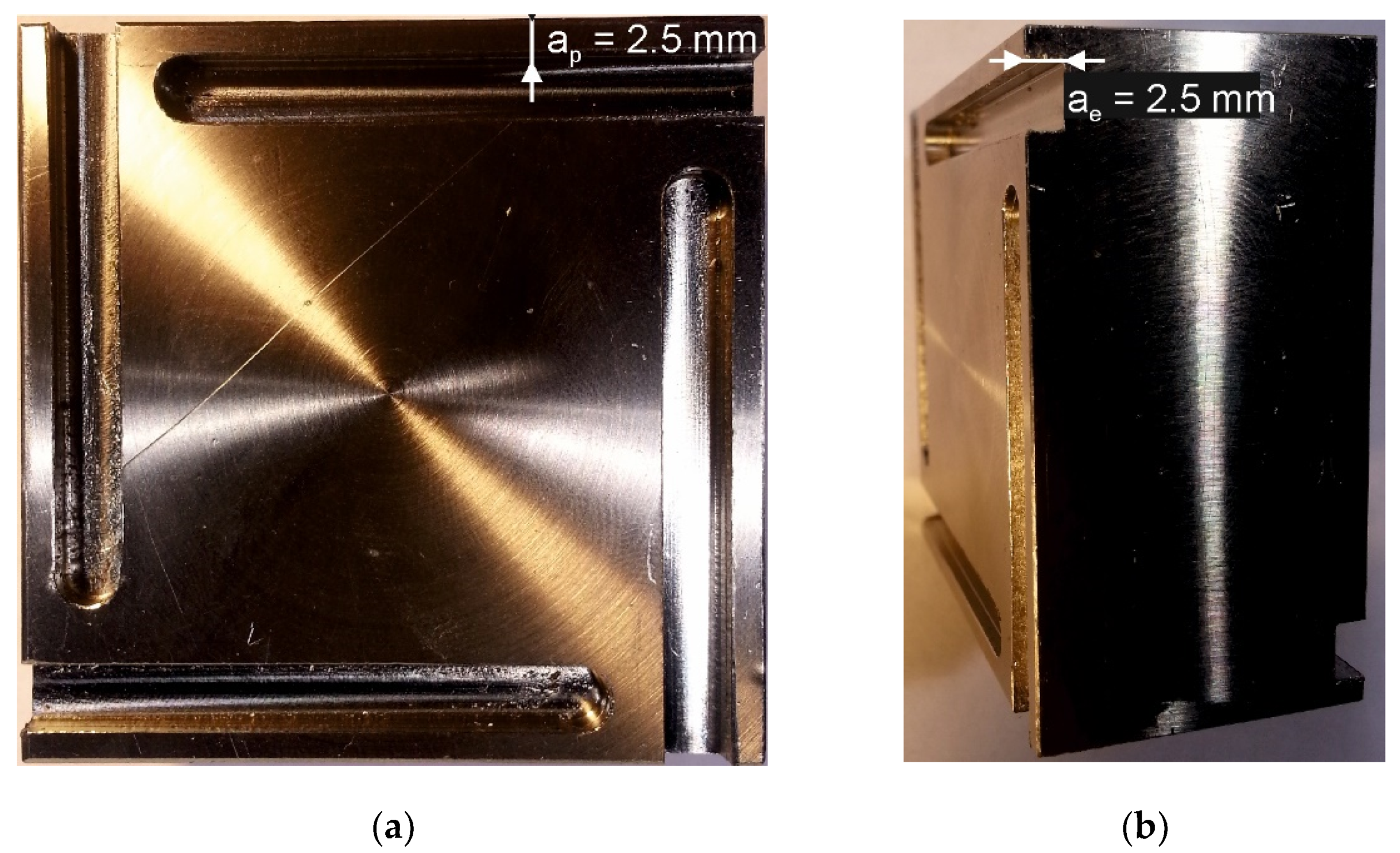


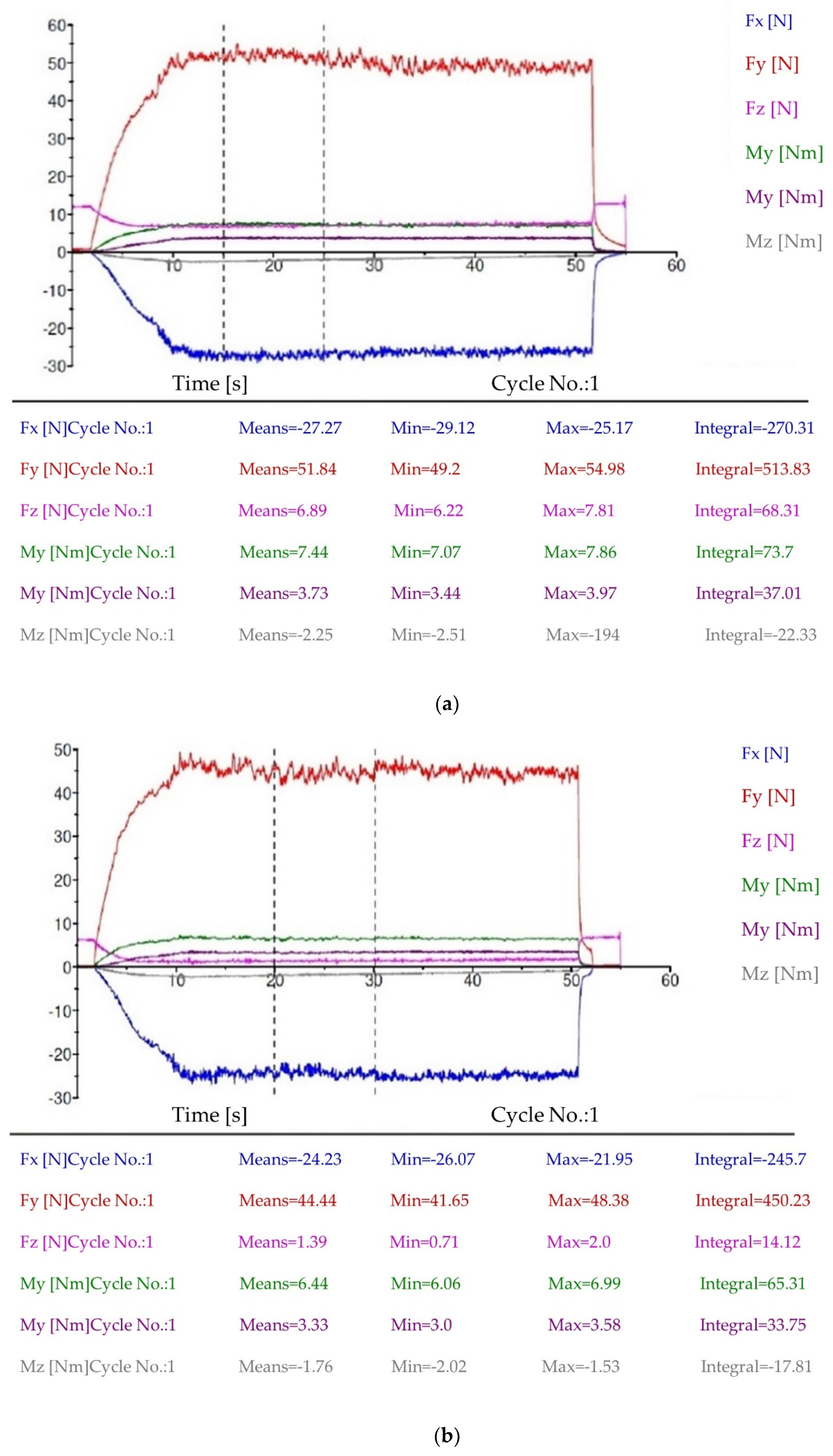
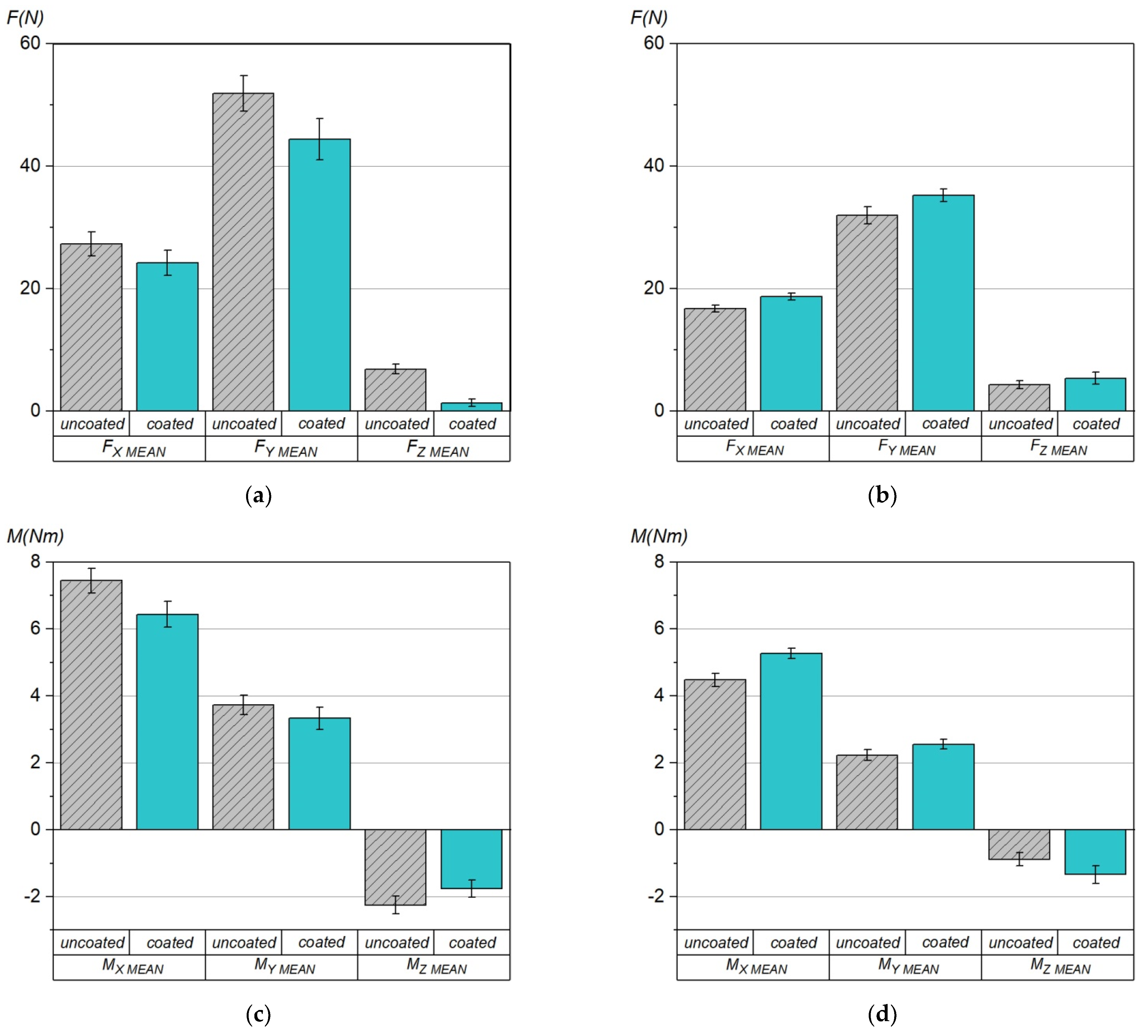
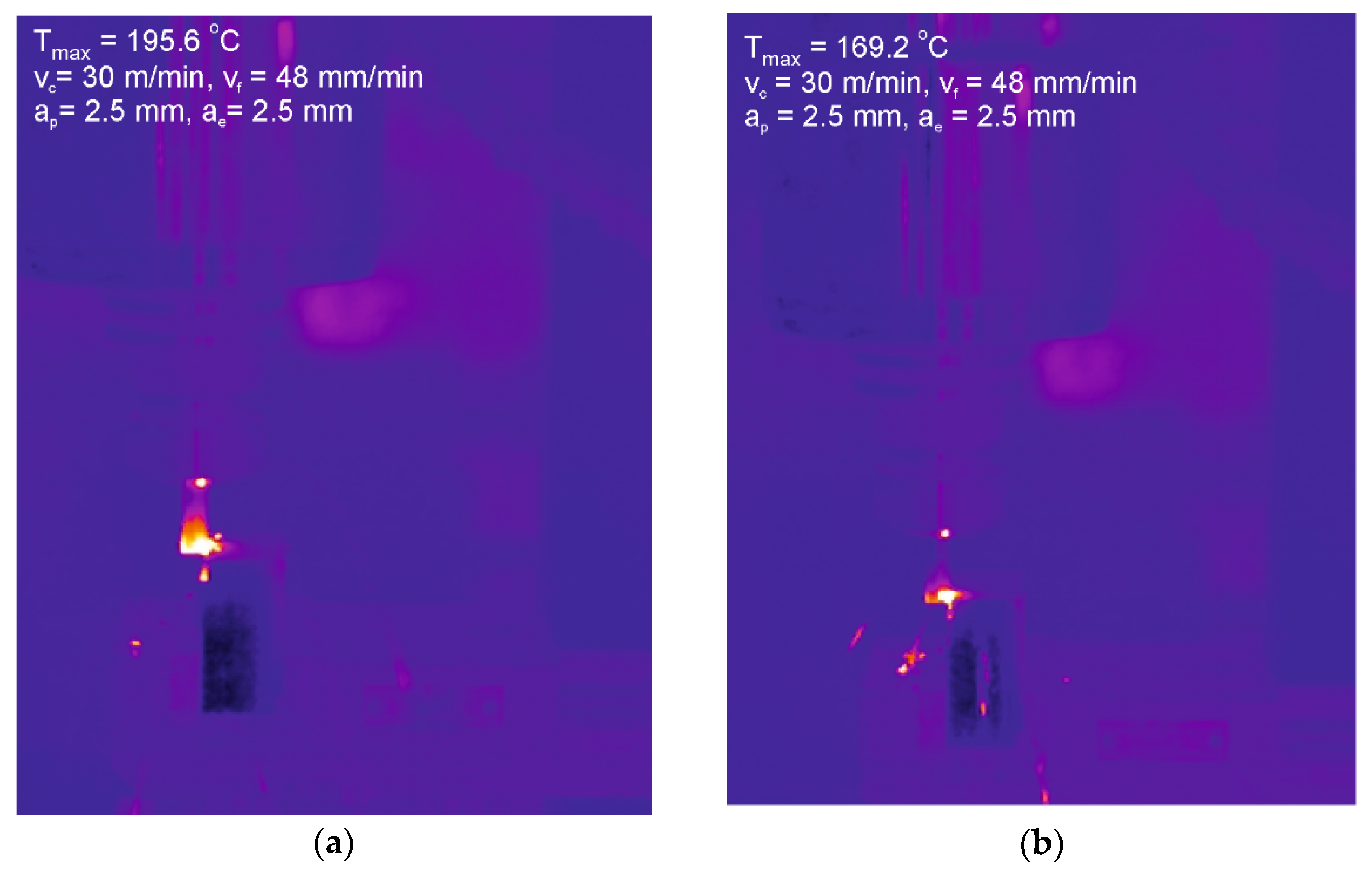
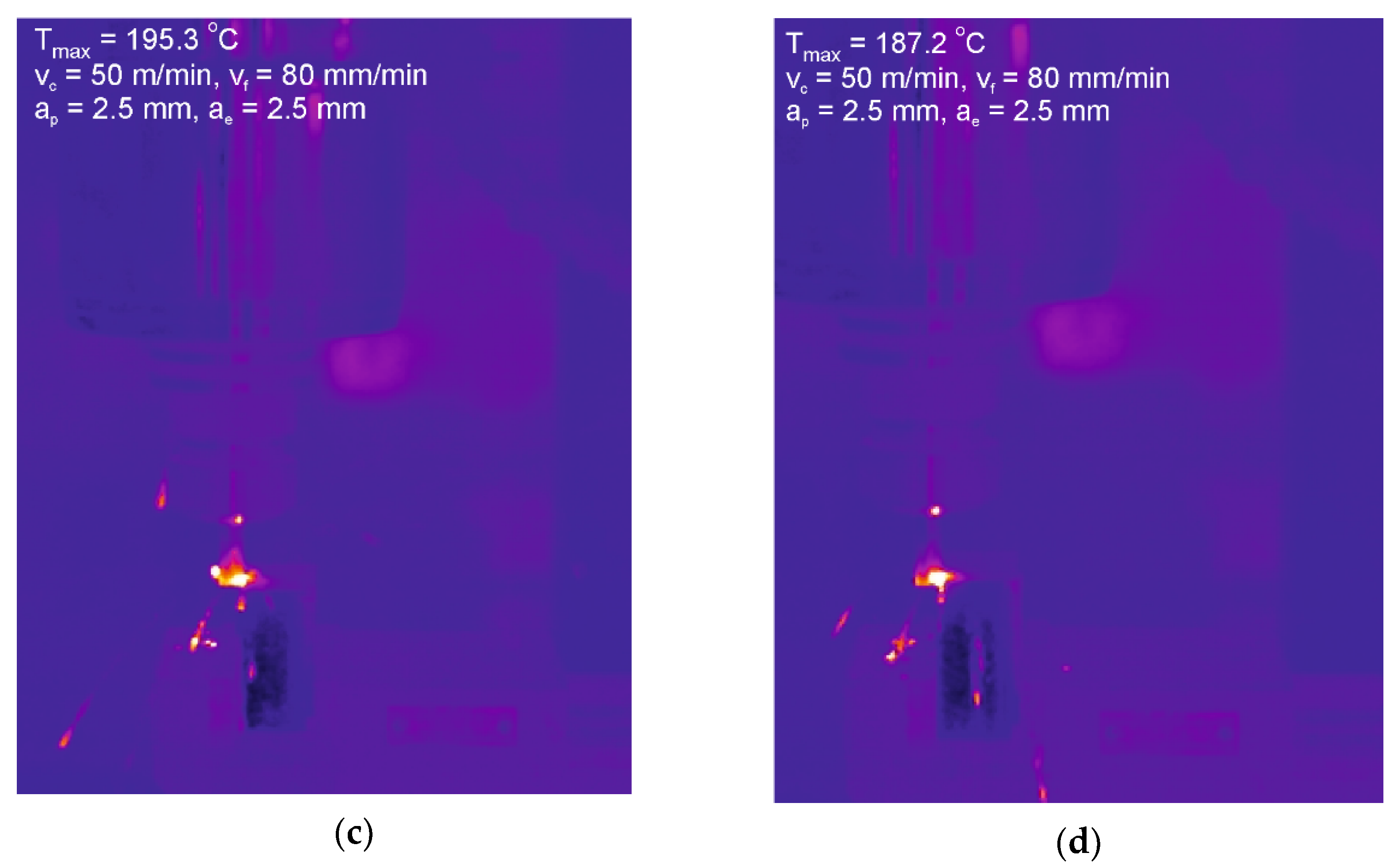

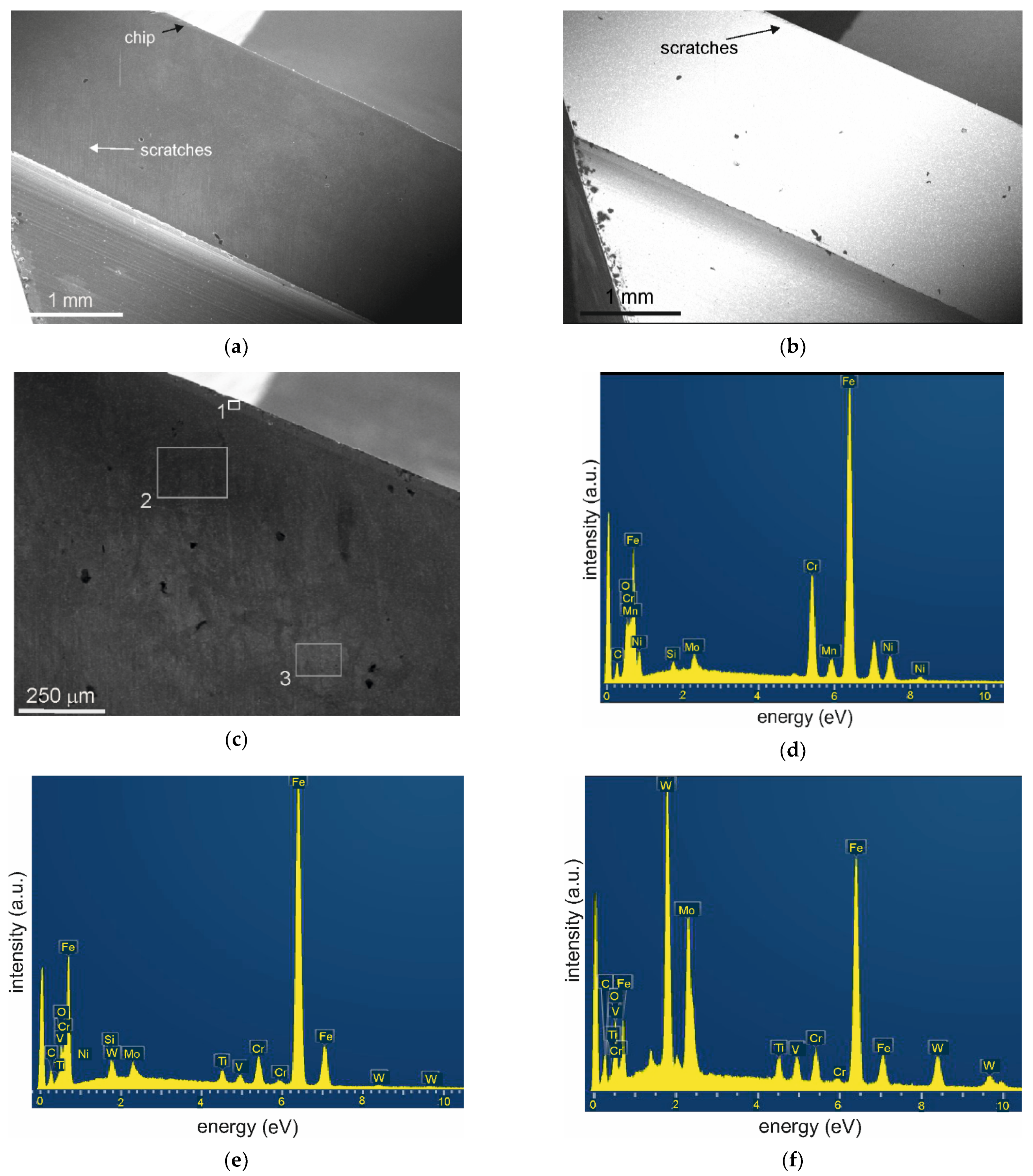
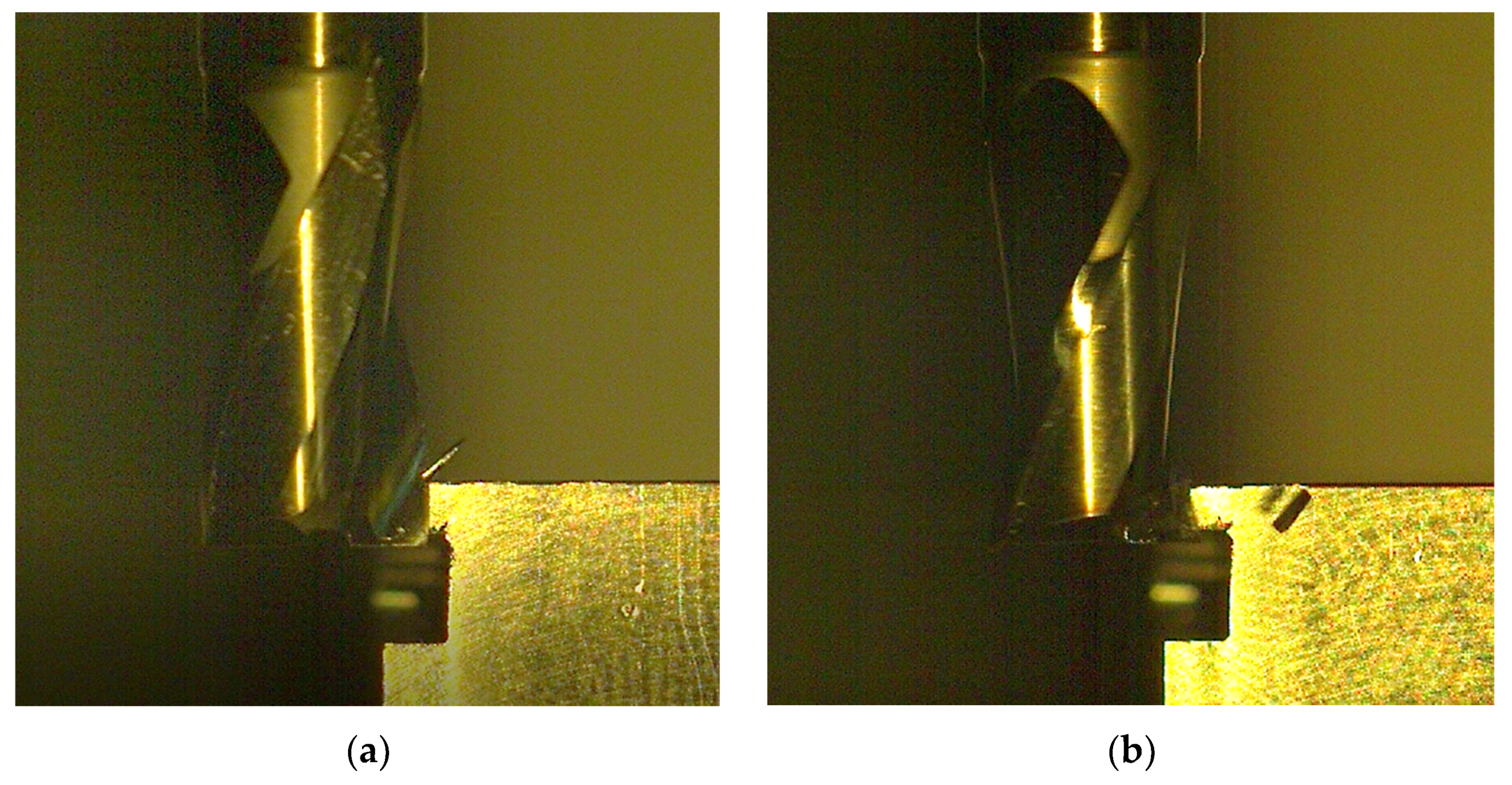
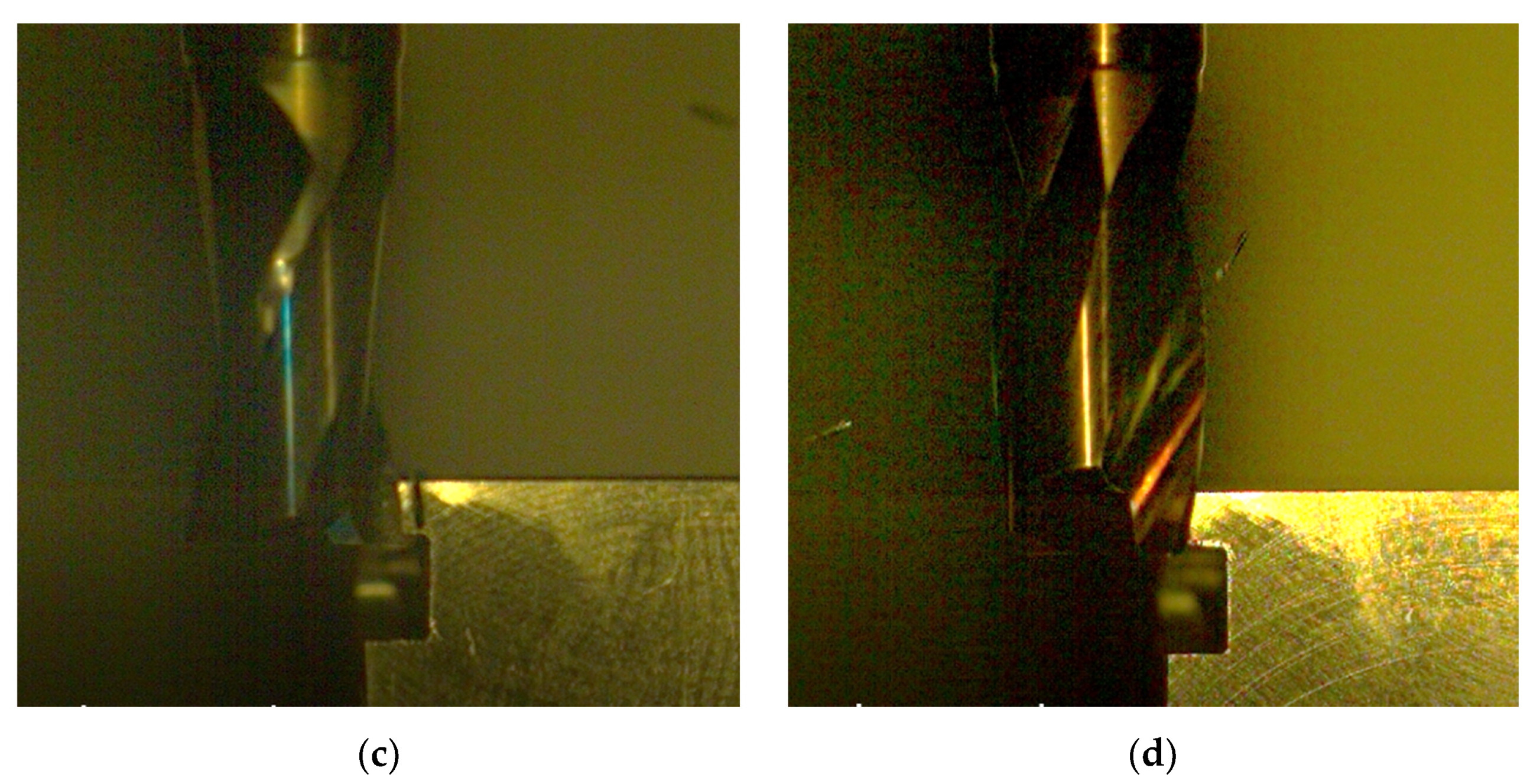
| Item | Composition [% wt.] | Density [g/cm3] | Thermal Conductivity [Wm−1K−1] | Thermal Expansion ×10−6 [K−1] | Hardness | Young Modulus [GPa] |
|---|---|---|---|---|---|---|
| TiB2 target | 99 (TiB2) | 4.45 | 24–26 [16] | 3.7–6 | 25 GPa | 430 |
| Ti3SiC2 target | 97 (Ti3SiC2), 1 (TiCx), 2 (TiSi2) | 4.42 | 32–37 [23] | 8.6–9.7 | 4 GPa | 320 |
| AISI M2 steel (hardened) | Fe/C 0.9, W6, Co5, Cr4, Mo5, V2 | 8.13 | 41 [24] | 10–12.6 | 97 HRB, 62 HRC | 210 |
| AISI 316L steel | Fe/C 0.03, Cr18, Ni12, Mo2.5, Mn2, Si1 | 8.00 | 15 [25] | 16-18 | 80 HRB | 200 |
| Item | vc [m/min] | vf [mm/min] | ap [mm] | ae [mm] | l [mm] |
|---|---|---|---|---|---|
| V1 | 30 | 48 | 2.5 | 2.5 | 35 |
| V2 | 50 | 80 | 2.5 | 2.5 | 35 |
| Operating Parameters | Tool | Mean Tmax [°C] | Tmax [°C] |
|---|---|---|---|
| V1 | uncoated M2 | 135.2 ± 27.1 | 195.6 ± 3.8 |
| coated M2 | 118.3 ± 25.0 | 169.2 ± 3.4 | |
| V2 | uncoated M2 | 144.9 ± 22.3 | 195.3 ± 3.9 |
| coated M2 | 131.0 ± 22.1 | 187.2 ± 3.6 |
Publisher’s Note: MDPI stays neutral with regard to jurisdictional claims in published maps and institutional affiliations. |
© 2022 by the authors. Licensee MDPI, Basel, Switzerland. This article is an open access article distributed under the terms and conditions of the Creative Commons Attribution (CC BY) license (https://creativecommons.org/licenses/by/4.0/).
Share and Cite
Twardowska, A.; Ślusarczyk, Ł.; Kowalski, M. Impact of Deposition of the (TiBx/TiSiyCz) x3 Multilayer on M2 HSS on the Cutting Force Components and Temperature Generated in the Machined Area during the Milling of 316L Steel. Materials 2022, 15, 746. https://doi.org/10.3390/ma15030746
Twardowska A, Ślusarczyk Ł, Kowalski M. Impact of Deposition of the (TiBx/TiSiyCz) x3 Multilayer on M2 HSS on the Cutting Force Components and Temperature Generated in the Machined Area during the Milling of 316L Steel. Materials. 2022; 15(3):746. https://doi.org/10.3390/ma15030746
Chicago/Turabian StyleTwardowska, Agnieszka, Łukasz Ślusarczyk, and Marcin Kowalski. 2022. "Impact of Deposition of the (TiBx/TiSiyCz) x3 Multilayer on M2 HSS on the Cutting Force Components and Temperature Generated in the Machined Area during the Milling of 316L Steel" Materials 15, no. 3: 746. https://doi.org/10.3390/ma15030746








